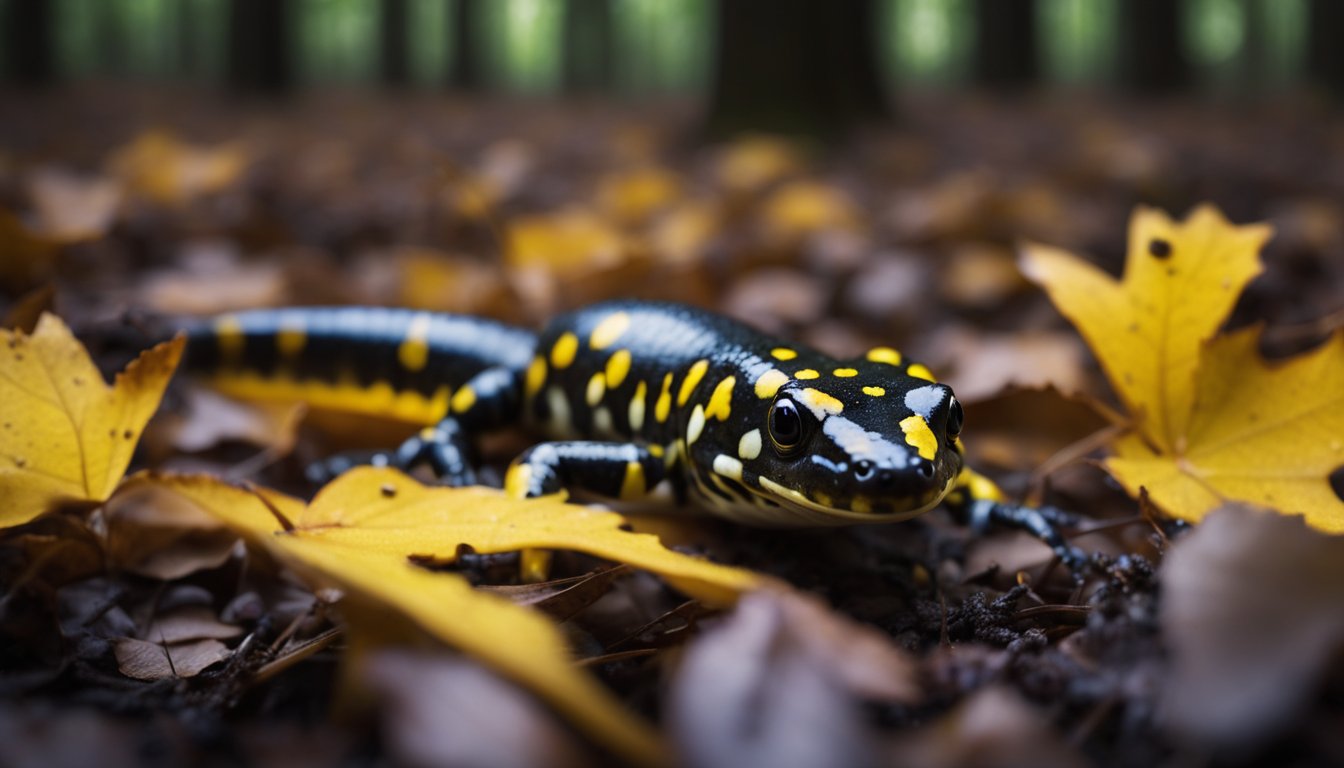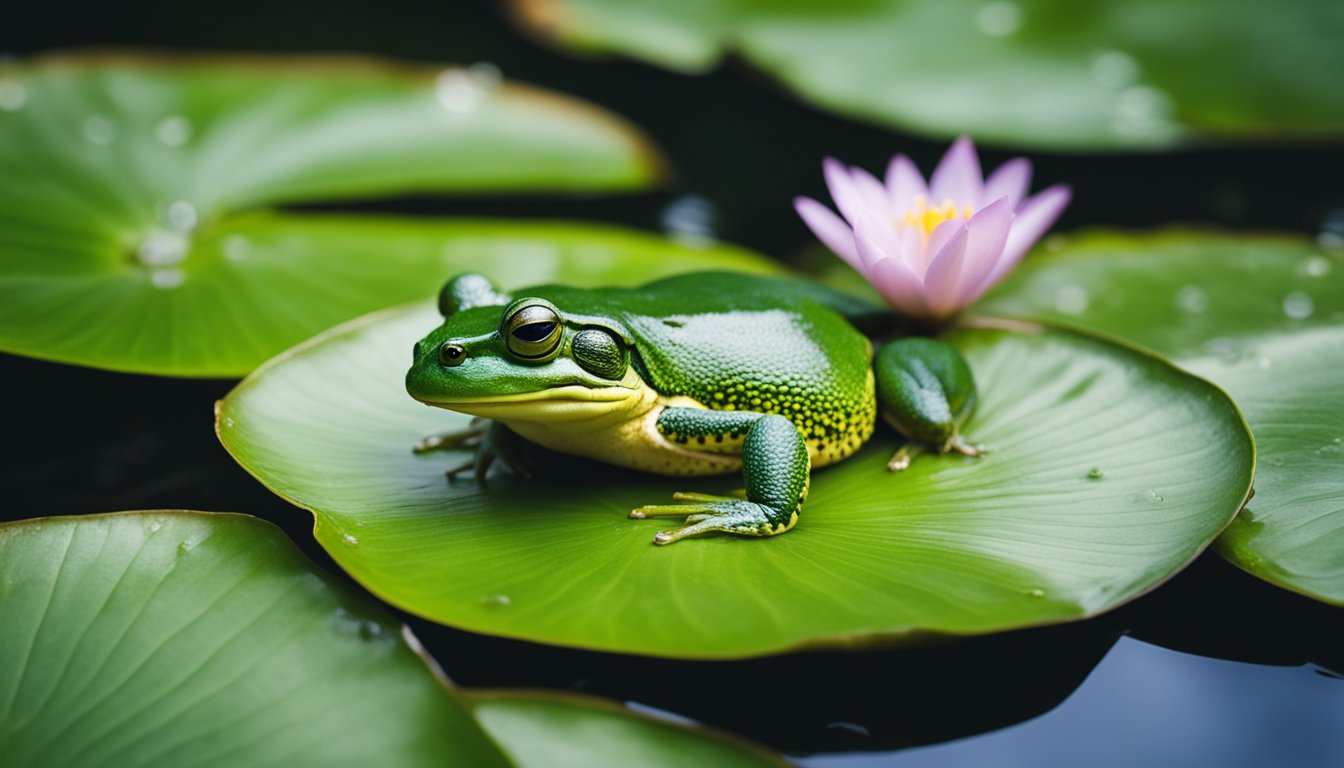Spotted salamanders are super cool amphibians that look like they could be part of a secret forest club with their dark colors and bright spots.
They’re not very big, about as long as a pencil, and they have a special talent for hiding.
These creatures are also known as Ambystoma maculatum, but that’s a bit of a mouthful, so we can stick to calling them spotted salamanders.

If we were to go on a forest adventure, we might be lucky enough to find spotted salamanders hanging out in damp, wooded areas.
Even though they spend a lot of time underground, during the spring, they make a special trip to ponds to lay their eggs.
It’s like their own version of a family reunion!
We tend to only see them at night or during rain when they come out to explore.
They have this neat trick where they breathe through their skin, and they need to keep it moist to do so.
It’s like they have superpowers, which is just one of the reasons why we find them so fascinating!
Discovering the Spotted Salamander

Let’s hop into the world of the Spotted Salamander, a cool critter also known by its fancy name, Ambystoma maculatum.
We’ll peek at what they look like, where they hang out, and how they make a living in the wild!
What Do They Look Like?
Spotted Salamanders are pretty neat to look at!
They usually wear a sleek black coat sprinkled with yellow or orange spots.
It’s as if they’re preparing for a costume party all year round!
These cool spots help them to blend in with the rocks, logs, and leaf litter.
When it comes to size, these guys are not too big and not too tiny – they can grow to be about 15-25 cm (that’s about as long as a ruler)!
Where Do They Live?
If we were to go on an adventure to find Spotted Salamanders, we’d need to check out deciduous forests in the eastern United States and even in eastern Canada.
They love to snuggle under leaf litter or tuck themselves away under logs and rocks.
When it’s time to grow their families, they head over to ponds or vernal pools – that’s where their larvae, with cute little gills, start their larval development.
Making a Living
So, what do these Spotted Salamanders munch on? Well, they’re carnivores, which means they love to eat other small critters.
Imagine watching them hunt with their sticky tongue to catch tasty insects, worms, slugs, and other invertebrates – that’s their favorite prey.
It’s like having a bug buffet every day!
The Circle of Life

Hey there, young explorers!
We’re about to dive into the fascinating life cycle of the Spotted Salamander, also known as the yellow-spotted salamander.
From their start as tiny eggs to becoming secretive adults, let’s discover how they grow and who they share the forest with.
From Eggs to Adults
In the cool, early spring, just as the snow starts to melt away, Spotted Salamanders begin their amazing journey.
These creatures head to breeding ponds where they lay clusters of eggs, known as egg masses or clutches.
You might be surprised to learn that each clutch can have up to 250 eggs!
The eggs are snuggled in a protective layer of jelly that keeps them safe.
But here’s something super cool: the eggs have a helper!
A type of symbiotic algae, called Oophila amblystomatis, lives inside the egg and gives the larval salamanders oxygen.
And guess what? The larvae give the algae the nutrients it needs to grow. It’s like having a green buddy helping you breathe!
It takes about 4 to 7 weeks for the salamander eggs to hatch into little juveniles that swim around with gills.
As they grow up, they change; they lose their gills, develop lungs, and are then ready to live on land.
Under the right conditions, these spotted friends can live for up to 20 years in the wild.
Friends and Foes
Spotted Salamanders have plenty of buddies in the forest, like the red-backed salamander.
But they also have to watch out for some not-so-friendly animals.
Predators like raccoons, skunks, turtles, snakes, and even fish might try to munch on them.
Our salamander pals have a few tricks to keep safe.
They have glands that produce a toxin which makes them taste pretty yucky to predators.
Have you ever heard that lizards can drop their tails if they get caught? It’s called autotomy, and Spotted Salamanders can do it too!
Plus, they have fantastic regenerative abilities which means they can grow back parts of their bodies if needed.
However, Spotted Salamanders, especially in places ranging from northern Georgia to Texas, and up to Nova Scotia by Lake Superior, need our help.
While their conservation status isn’t super alarming right now according to the IUCN, they do face threats like disease, habitat destruction, and nasty chemicals like the herbicide atrazine which can harm their population.
It’s our job to keep an eye on these creatures and protect them so they can keep hopping along the circle of life for many years to come.






Add Comment